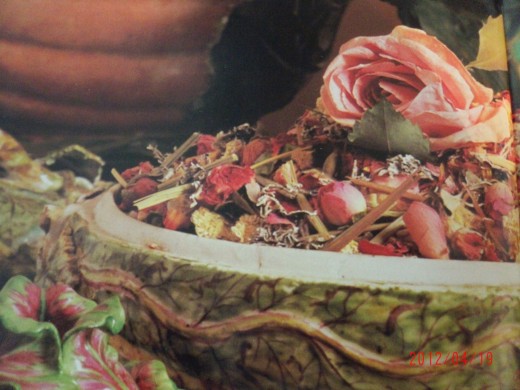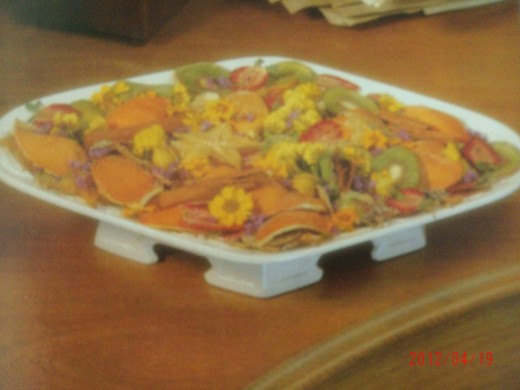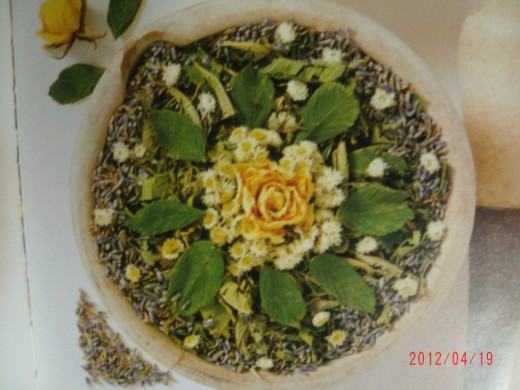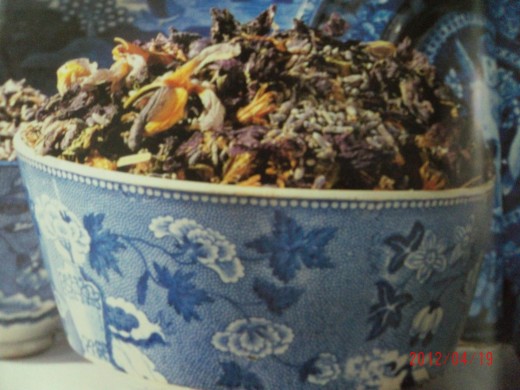- HubPages»
- Arts and Design»
- »
- Flower Crafts
Updated on August 3, 2015
The scent of potpourri can soothe your frazzled nerves, lull you to sleep, bring to mind cherished memories and even clear your sinuses. Man has always been drawn to the scent of flowers and herbs to make their living conditions more pleasant. Natural fragrances have been used since the beginning of time and the production and use of them have had a long and mysterious history. It all began when our ancient ancestors scented the air with burning wood. The Egyptians used scented materials to adorn themselves, appease the gods, scent the air and embalm the dead. Throughout the middle ages aromatic plants and herbs were used to cover up poor hygiene and even poorer sewerage and rubbish disposal. 'Sweet bags' were hung in living areas and placed on window sills, to act as air fresheners. Flowers and herbs were strewn on the floor to rid the house of rodents and other pest. Most homes during this time period had a 'still room'. A 'still room' was a warm, dry room where flowers and herbs were hung up to dry and oils were drawn from flowers by distillation (which is where the name 'still room' comes from). The 'still room' was where all of the day to day medicines, cleaning products and scented materials were made. Even though dried scented flowers were used for centuries, the term potpourri was not used to described this scented mixture until the mid 18th century. Potpourri was originally a culinary term for a stock-pot of meat and vegetables. It literally meant "rotten pot".
Two Methods of Making Potpourri
There are basically two main methods of making potpourri, the dry method and the moist method. The dry method is easier and quicker and the moist method, the more traditional method, is more involved and time consuming.
The Dry Method
The dry method is easier and the results are more attractive. There are three simple rules to consider when making dry potpourri. The first rule is that the flowers, herbs and leaves must be dry. The petals and leaves should be the crispiness of cornflakes. Even a trace of moisture can cause mildew to form. The second rule of making dry potpourri is; the potpourri should look as beautiful as it smells. When picking the ingredients, consider the colors, shapes and textures of the flowers, herbs and leaves. How they will look together is as important as their fragrance. The third rule, is to mix longer than you think is necessary. The more you mix and the more each petal comes in contact with the scents and fixatives, the more perfect the blend and scent. Mix by lifting and taking from the inside of the pile out and bring the outside of the pile in.
5 Basic Ingredients of Dry Potpourri
There are five basic ingredients of dry potpourri. The first is the scented and decorative ingredients, the flowers, fruit peels, wood and bark. This is the most important group; it provided the main scent and the visual appeal of the potpourri. The second ingredient is the scented herbs; like lavender, rosemary or mint. The herbs add a layer of complexity to the fragrance. The next group is the spices; star anise, cardamom, or cinnamon all add a rich, warm, depth to the fragrance. The fourth ingredient is the fixative, which plays a key role in the making of potpourri. A fixative delays the evaporation of the fragrance and helps blend the ingredients together by absorbing and retaining the scented oils that give the potpourri its perfume. If fixatives are not used the potpourri would quickly lose its fragrance. Orris root and gum benzoin are commonly used as fixatives. The last group, the essential oils, can either dictate the fragrance of the potpourri entirely or simply add to it, depending on how much you use. Essential oils are also known as aromatic oils, flower oils and potpourri oils. They are distilled, expressed or extracted from plants and are a single pure scent.
Basic Dry Potpourri Recipe
- Gently mix all dry ingredients (flowers, herbs, leaves, spices and fixatives) together in large glass or glazed pottery bowl. Plastic or wooden bowls tend to retain odors and will absorb the essential oils.
- Using an eyedropper, scatter the drops of the essential oil all over the dry ingredient mixture and mix with a metal spoon. Be extremely gentle when mixing to avoid crushing the more delicate ingredients. Remember to mix thoroughly.
- Place the mixture in an airtight container and leave in a dark, dry, cool place to cure for about 4 weeks. The longer you leave the potpourri the more mature the fragrance will become.
- Everyday or two gently turn the contents with a spoon, so that the oils and scents will be evenly distributed.
- After it's cured, the potpourri is ready to be placed in a decorative container.
The Moist Method
The moist method is the oldest method of making potpourri, it differs from the dry method in that is uses flowers and herbs that are not fully dried and the mixture takes more time to blend. This method was originally called 'sweet jars', and combines fresh or partially dried flowers, herbs, leaves and spices with large quantities of salt. The salt used is unrefined, coarse salt; rock, sea or kosher salt, work well. Do not use fine kitchen salt that is refined and iodized. The finished product has a stronger scent and last longer than potpourri made by the dry method. The potpourri produced this way is not as attractive as potpourri made by the dry method. The salt used, removes all of the color from the flowers; however the natural, aromatic oils in the flowers and herbs are retained for a longer period of time.
Basic Moist Potpourri Recipe
- Partially dry the flowers and herbs. When the petals become limp and have a soft, leathery texture they are dry enough. If the petals become too dry they cannot be used in a moist potpourri.
- Place a layer of petals in a non-porous, pottery crock and sprinkle with a layer of salt. Use a ratio of three to one, petal to salt. This will absorb the excess moisture from the partially dried petals. Continue layering until the crock is full.
- Place a plate that is slightly smaller than the crock on top of the petal/salt layers. Place a heavy weight on top of the plate. The weight will push the petal/salt layers down into the crock. Each day press on the plate/weight in order to make the mixture cake together. Cover and store the crock in a dry place.
- Each day, before pressing on the mixture, remove the plate and weight and stir. Use a wooden spoon; scrape any residue from the sides of the crock, then turn the mixture as if you were folding in egg whites. Froth may appear, just mix it in with the petals. If liquid accumulates in the bottom of the crock, drain it off.
- Continue the daily stirring and pressing until the ingredients begin to turn into a dense cake.
- Empty the caked material from the crock into a glass or glazed bowl. Crumble with your hands.
- In another glass or glazed bowl mix whatever herbs and spices you will be using, along with the fixatives and essential oils.
- Combine the crumbled petal mixture, the herb/spice mixture, and the fixatives and essential oils, blend with a metal spoon.
- The potpourri at this stage will smell "raw", but the aging process will fix this. Return the ingredients to the crock and press them down with the plate/weight until they are tightly packed.
- Cover the crock with a piece of muslin and secure with a rubber band.
- Place the muslin-covered crock in a dark, dry place for 6 weeks.
- After it's cured, the potpourri is ready to use. Place it in a non-see through container and cover with a decorative porous cloth.
Now that you have the two basic recipes for potpourri, experiment! The great thing about making your own potpourri is that there are no rules, you can do whatever you want, you are the creator. Apart from following some basic guidelines, you are able to change or create any recipe you want. Enjoy!
© 2012 susiempn




